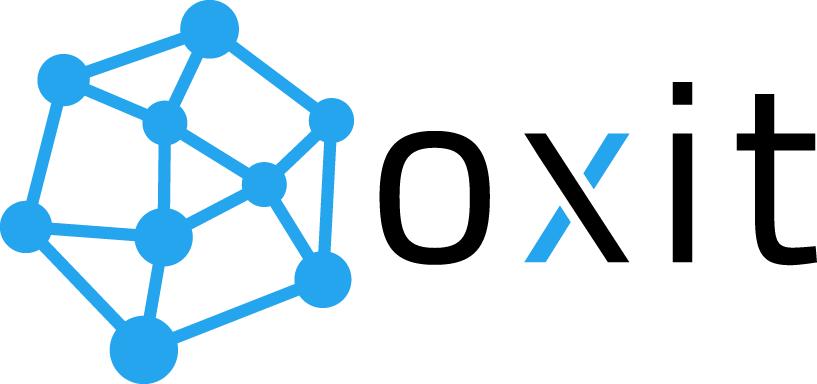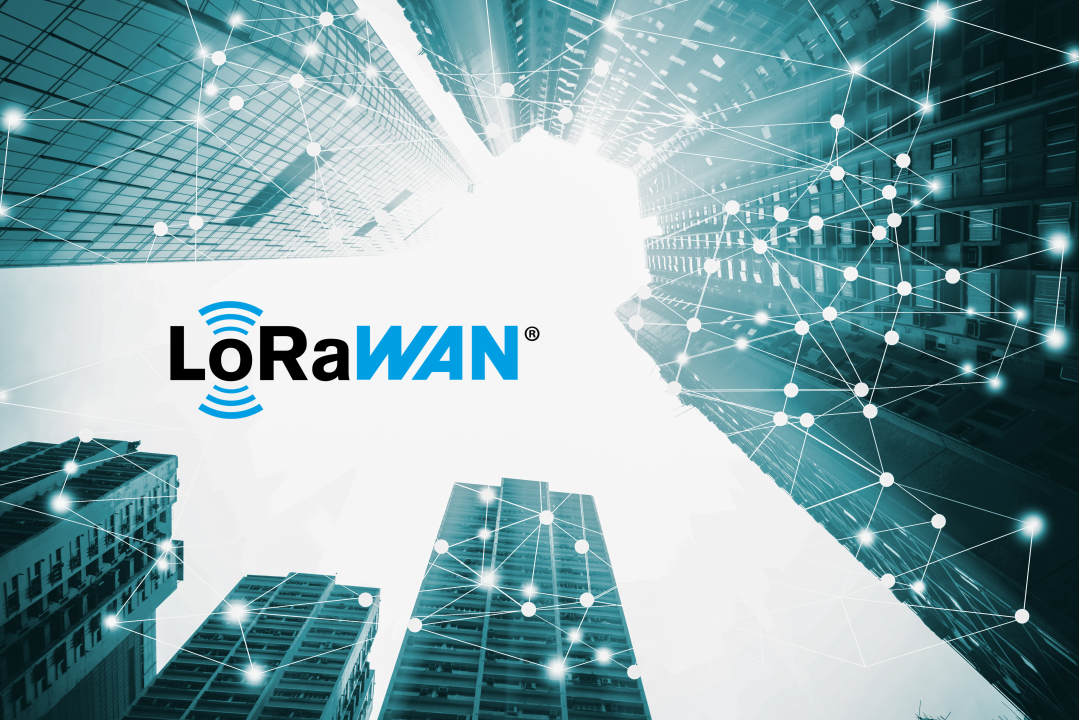LoRaWAN 101: Essential IoT Knowledge
Introduction to LoRaWAN
LoRaWAN stands as a key technology in the Internet of Things (IoT) landscape, enabling long-distance communication and minimal power consumption for a multitude of devices. This introduction provides an in-depth look at both LoRa and LoRaWAN technologies, emphasizing their functionalities, operational parameters, and significance in modern IoT applications.
What is LoRa?
LoRa (Long Range) is a spread spectrum modulation technique derived from chirp spread spectrum (CSS) technology, which is used extensively for long-range wireless communications. Operating within unlicensed ISM bands (sub-gigahertz frequencies), LoRa enables data transmission over distances of up to 15 kilometers in rural areas and 2 to 5 kilometers in urban settings. Its ability to maintain communication over long distances while consuming very low power makes it exceptionally well-suited for devices that require long operational life without the need for frequent recharging.
What is LoRaWAN?
LoRaWAN, short for Long Range Wide Area Network, is a protocol that leverages the LoRa technology to create smart, efficient IoT networks. As a MAC layer protocol, LoRaWAN defines the system architecture and communication protocol for combining the long-range and low-power benefits of LoRa with efficient management of communication between connected devices and applications. The key attributes include:
Smart Communication Management:The protocol’s MAC layer optimizes network performance by:
- Enabling bi-directional communication
- Adapting data rates to balance range and power consumption
- Managing channel access to minimize interference
Flexible Device Classes: LoRaWAN adapts to diverse needs with three device classes:
- Class A for maximum energy efficiency
- Class B for scheduled communications
- Class C for the lowest latency with continuous listening
The image below highlights the key differences between LoRa and LoRaWAN:

Applications of LoRaWAN?
LoRaWAN powers diverse IoT applications across industries:
- Smart Agriculture: Optimizing irrigation through soil moisture monitoring
- Smart Cities: Enhancing urban efficiency with smart parking and waste management
- Asset Tracking: Long-range tracking in areas with limited cellular coverage
- Environmental Monitoring: Collecting data from remote areas
- Industrial IoT: Improving operational efficiency through equipment monitoring
LoRaWAN Network Infrastructure
LoRaWAN enables devices known as end nodes, which lack direct internet access, to connect to the internet through a specifically designed infrastructure. This setup is depicted in the diagram below.
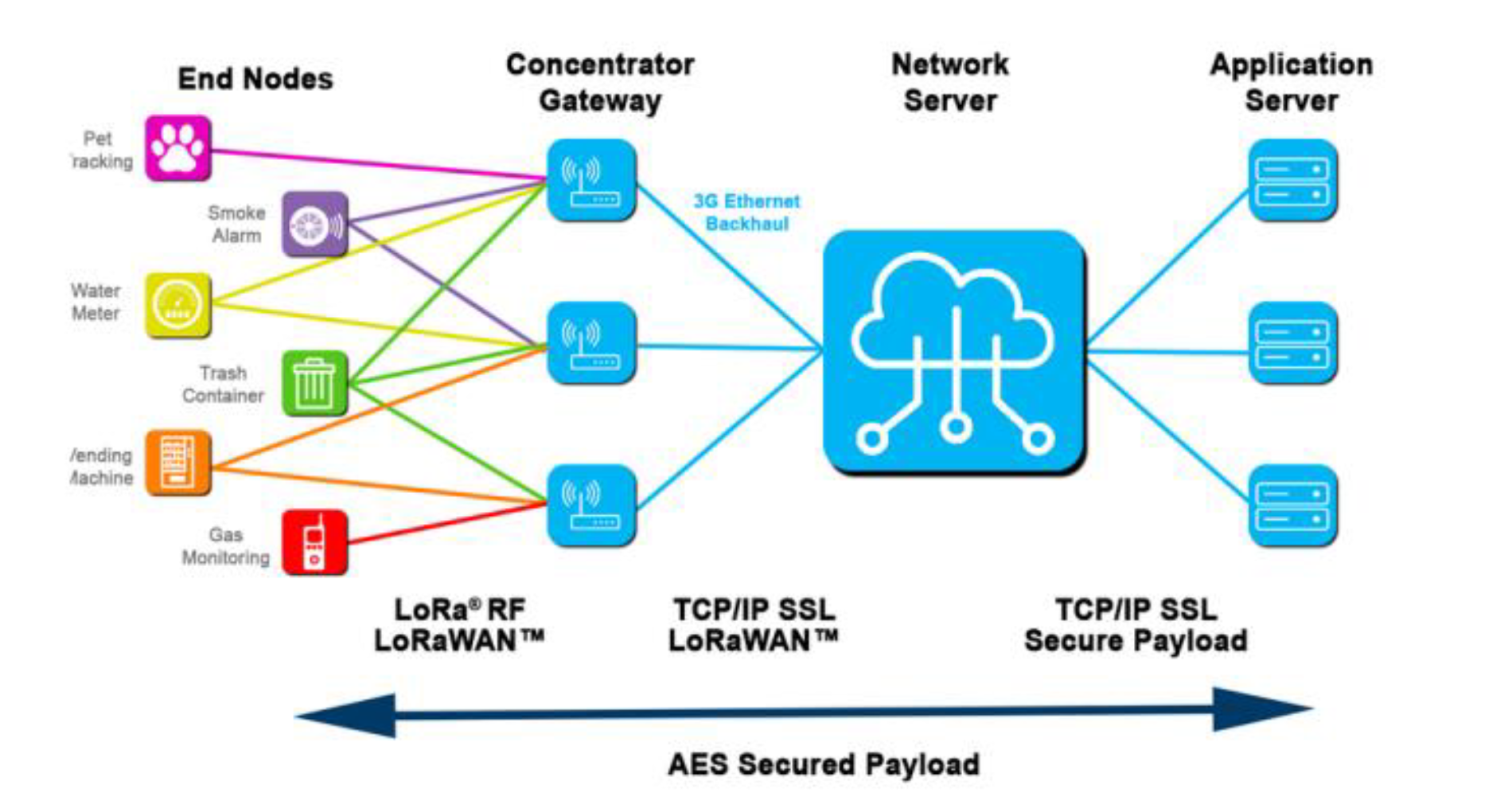
The LoRaWAN infrastructure employs a star-of-star topology with several key components ensuring efficient and secure data flow:
- End Nodes: Wireless devices equipped with LoRa modulation to communicate over long distances. End nodes can be various sensor and actuator devices like gas monitoring devices, pet trackers, or remote-controlled valves. They communicate with the network server through gateways.
- Gateways: Serving as the bridge, gateways forward data between end nodes and the network server using high bandwidth connections like Wi-Fi, Ethernet, or Cellular networks. They relay data without altering it, maintaining the integrity of the transmitted information.
- Network Server: The core of LoRaWAN operations, the Network Server manages data routing, deduplication, and integrity checks. It handles device addressing, data rate adaptation and coordinates communication between end devices and application servers. While it participates in the join procedure, it relies on the Join Server for key management in OTAA setups.
- Join Server: This component manages the secure join procedure for Over-The-Air Activation (OTAA) in LoRaWAN networks. It’s responsible for authenticating devices, generating and managing session keys, and securely distributing these keys to the Network Server and Application Server. The Join Server ensures that only authorized devices can connect to the network, playing a crucial role in LoRaWAN security.
- Application Server: This component processes data from the network server. It uniquely allows end nodes to communicate through any in-range gateway within their LoRaWAN network linked to the same application. This design allows for seamless data transfer even as nodes move within the network coverage, with AES encryption ensuring end-to-end security.
- LoRaWAN Network Server (LNS): This term often refers to a comprehensive system that typically encompasses the Network Server, Join Server, and sometimes the Application Server functionalities. LNS solutions can be deployed as cloud-based services, on-premises systems, or even integrated within advanced gateways, offering flexibility in network design and management for various IoT deployment scenarios.
LoRaWAN Network Server (LNS)
The LoRaWAN Network Server (LNS) plays a central role in the LoRaWAN architecture, acting as the intermediary that transfers and translates messages from end devices through gateways to the application server, and vice versa. It orchestrates the network’s operations, including the join procedure, authorization of end nodes, and the secure exchange of data both upstream and downstream. Additionally, the LNS is responsible for key management and maintaining the overall integrity and efficiency of the network.
Central Role: Manages and secures data traffic from end nodes to the application server via gateways, ensuring that communications are both efficient and secure.
Diverse Options: Users can choose from various LNS providers, such as Senet, The Things Stack with TTN or TTI, Everynet, AWS IoT Core for LoRaWAN, Helium, Chirpstack, and MultiTech, each offering tailored features to meet different network demands.
Types of LNS Deployments
There are three primary deployment models for LNS, each with distinct characteristics concerning deployment, scalability, security, and cost:
- Integrated LNS: Embedded within the same hardware as the LoRaWAN gateway.
- Cloud-Based LNS: Hosted on cloud infrastructure managed by third-party service providers.
- On-Premise Hosted LNS: Hosted on self-managed servers, not integrated into the gateway hardware.

LoRaWAN Gateways
LoRaWAN Gateways act as conduits between end devices and the network, managing the flow of data in a LoRaWAN system. They are essential for translating and forwarding the packets from the LoRa protocol used by the end devices to high bandwidth protocols like Ethernet, Wi-Fi, or Cellular that connect to the wider internet. Below are some essential aspects to understand about these gateways:
Data Handling: A single gateway can handle a few hundred end devices, limited primarily by the amount of data it processes, which depends on data rates and message volume.
Connectivity Protocols: End devices connect to gateways using the LoRa protocol, with gateways forwarding data to the network using high-bandwidth protocols like Ethernet, Wi-Fi, or Cellular.
Connectivity Infrastructure: How the LoRaWAN Gateway establishes and maintains a connection with the LoRaWAN Network Server.
- Semtech UDP Packet Forwarder: Transmits data using a simple UDP protocol.
- Semtech Basic Station: Utilizes TLS encryption for secure data transmission.
- Proprietary Packet Forwarder: Custom solutions that may offer specific features for enhanced performance.
Special Cases
Some LoRaWAN Gateways, offer integrated LNS functionality. These gateways can enable Private LoRaWAN Networks that operate independently of cloud services, ideal for:
- High-security applications
- Areas with unreliable internet
- Low-latency industrial IoT
- Temporary or mobile deployments
While providing a powerful option for specific LoRaWAN use cases and offering greater autonomy, these integrated solutions may have scalability limitations compared to cloud-based infrastructure.
Gateway Types and Comparison
There are two main types of LoRaWAN Gateways based on their channel operation: Single Channel and Multichannel. Here’s a comparison of their key attributes:

Additionally, gateways can be categorized based on their installation environments as either Indoor or Outdoor.

LoRaWAN Network Types
LoRaWAN networks can be set up in various configurations to meet different requirements regarding scale, control, security, and cost. These networks are categorized into public, private, hybrid, and community networks, each serving unique purposes and applications.
Public LoRaWAN Network: Operated by third-party providers, these networks offer connectivity without the need for individual infrastructure.
- Scalability: Easily add devices without expanding infrastructure.
- Cost-Efficient: Minimizes investment by using shared resources.
- Managed Services: Includes maintenance, technical support, and reliability.
- Subscription-Based: Requires fees for device registration and network use.
Private LoRaWAN Network: Allows full control over the network, ideal for customized or secure applications.
- Enhanced Security: Tight control over data and network access.
- Customization: Tailor the network to specific operational needs.
- Low Latency: Faster data processing due to the proximity of network components.
- Self-Hosted: Operate your own gateways and manage all backhaul connections.
Hybrid LoRaWAN Network: Combines the benefits of both private and public setups.
- Flexibility: Use private networks for local control, interconnecting with public LoRaWAN infrastructure for extended coverage. (e.g., AWS IoT Core for LoRaWAN with Everynet, Senet Extended Coverage)
- Seamless Roaming: Enables devices to connect across multiple network operator coverage areas through roaming agreements.
- Optimal Coverage: Ideal for applications like asset tracking across different regions.
- Cost-Effective: Manage costs by leveraging public infrastructure where appropriate.
A look at key differences between Private and Public Network
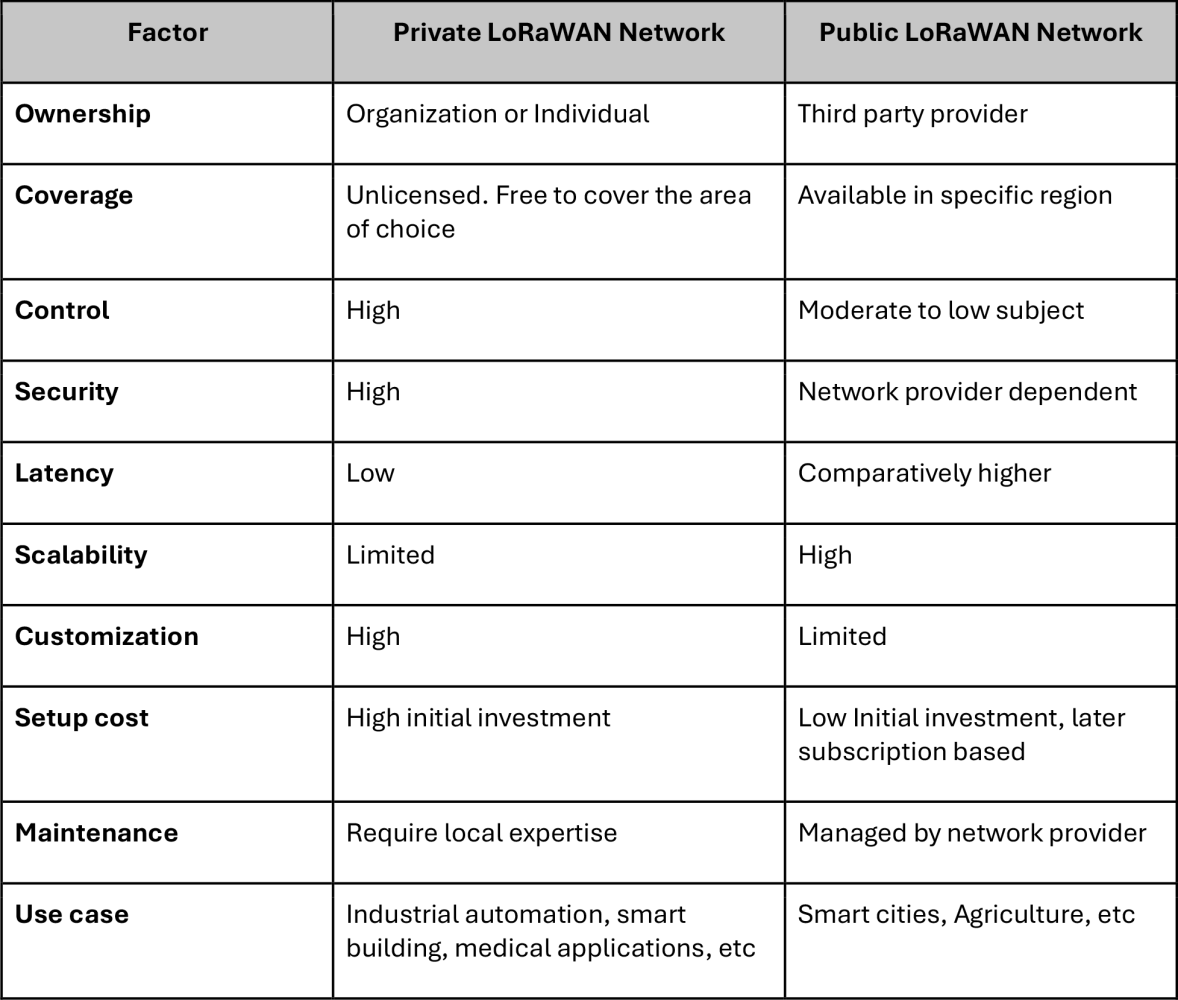
LoRaWAN vs Other IoT Wireless Technologies
As the IoT landscape grows, numerous wireless technologies compete to connect devices effectively. Understanding the technical specifications and performance metrics of these technologies is essential for selecting the appropriate one for your IoT applications. LoRaWAN is particularly noteworthy for its power efficiency, range capabilities, and data rate, making it suitable for a wide array of use cases.
Power Efficiency: LoRaWAN’s low power consumption extends battery life significantly, ideal for devices in remote locations.
Data Rate: It offers lower data rates, which is adequate for sending small data packets like sensor readings.
Range: LoRaWAN provides extensive coverage, capable of reaching up to 15 kilometers in rural areas, far surpassing many conventional wireless options.
The image below categorizes various wireless technologies, underscoring their fundamental differences:

The next image below shows that while LoRaWAN operates at lower bandwidths, it achieves greater range than most wireless technologies, which is beneficial for applications that do not require high throughput.
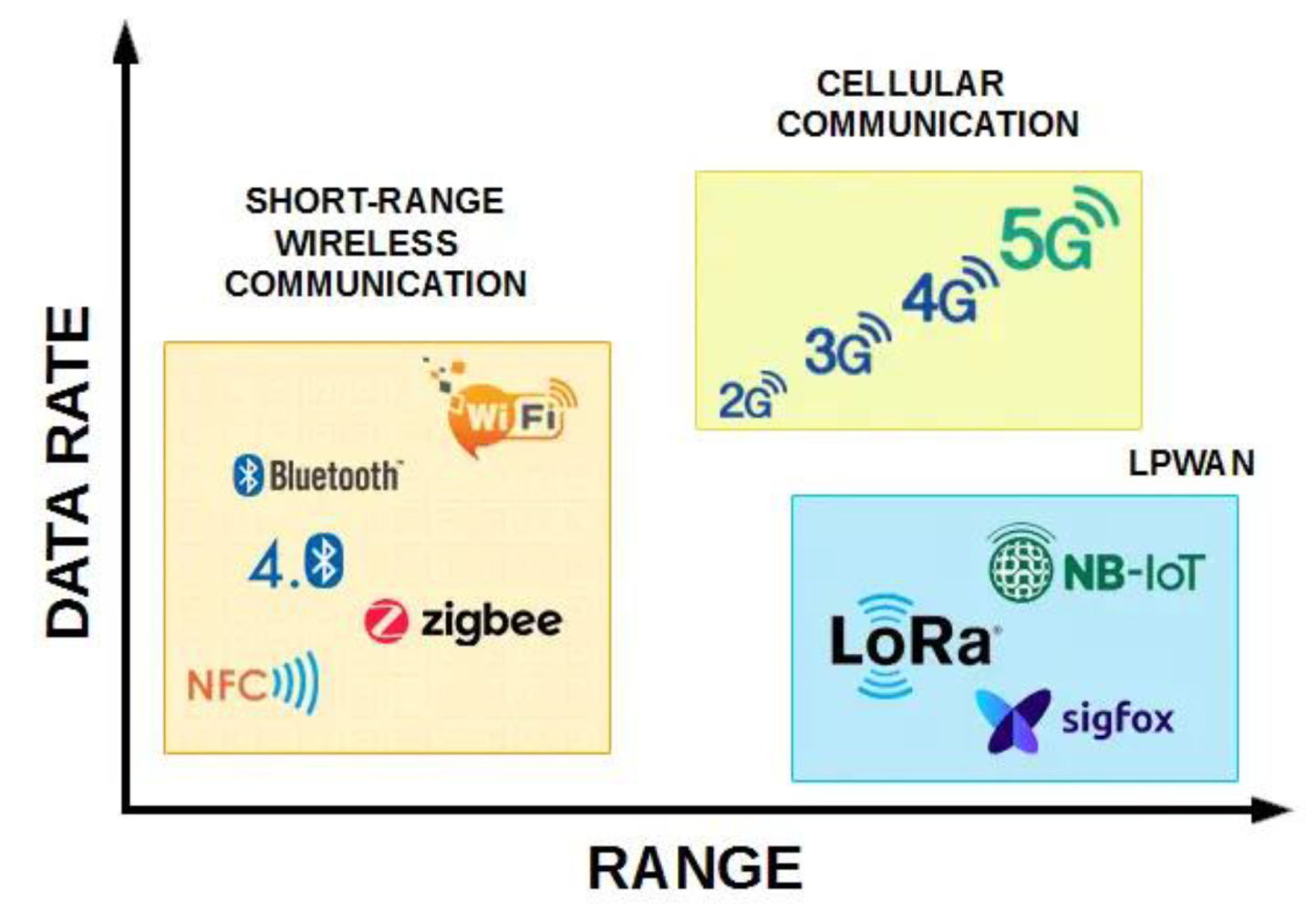
Comparison between different LPWAN technologies
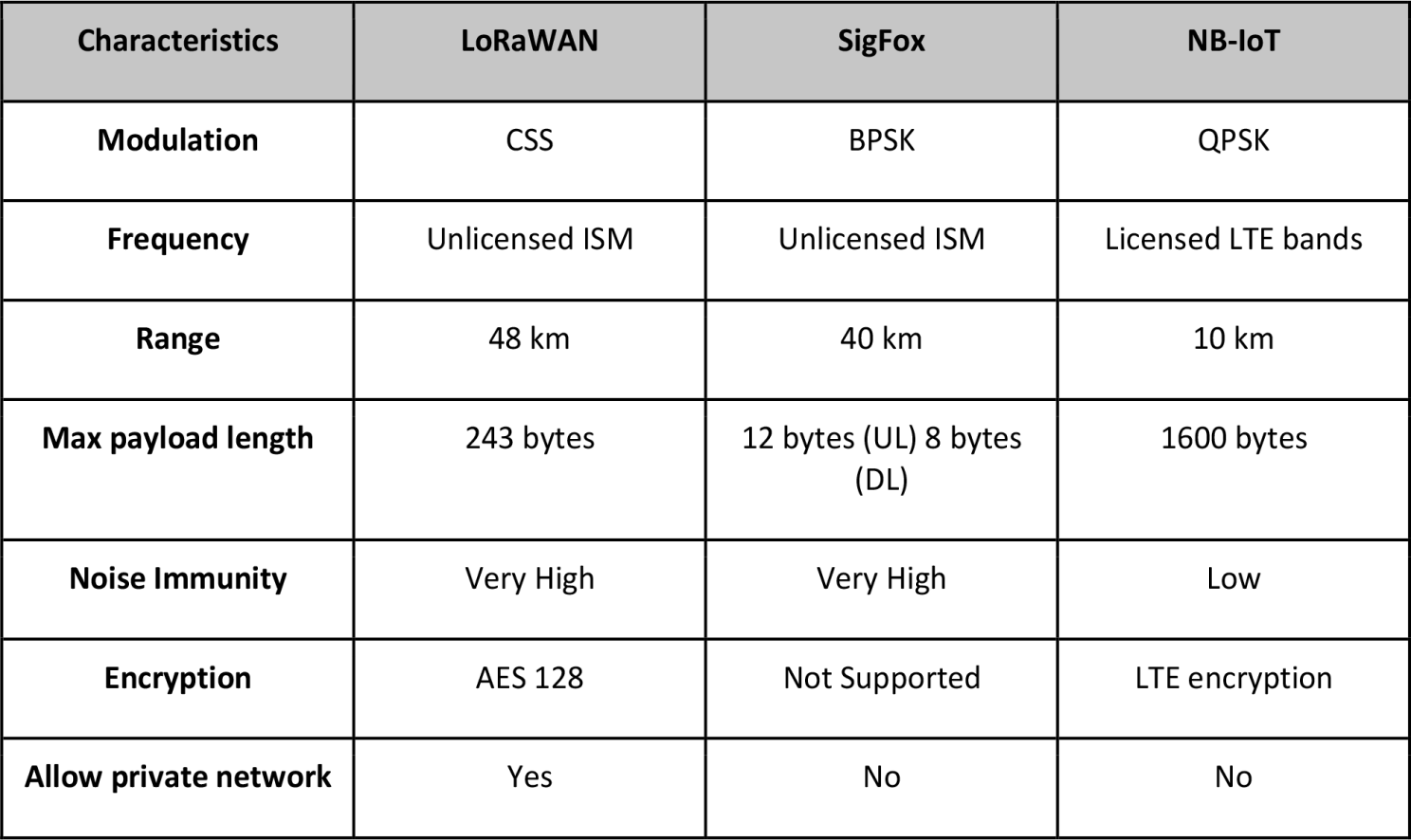
Getting Started with LoRaWAN
Gaining Hand-On Experience
For those new to LoRaWAN, building a proof of concept (PoC) is an excellent way to gain hands-on experience quickly. To get started:
- End Node (Things): Get off-the-shelf LoRaWAN end devices, such as temperature sensors or GPS trackers.
- Gateway: Procure a LoRaWAN gateway compatible with your region’s frequency band.
- LoRaWAN Network Server (LNS): Sign up for a free account with a LoRaWAN Network Server (LNS) service like The Things Network (TTN). Follow the provider’s documentation to connect your devices and gateway to the network.
- Application: Start experimenting with data collection and visualization.
With these elements, you can set up a LoRaWAN network suitable for diverse applications. This approach allows you to rapidly prototype and understand LoRaWAN’s capabilities without significant investment.
Building Commercial Solutions
As you move towards developing a full-fledged or commercial LoRaWAN solution, consider the following factors:
- Network range and coverage requirements
- Device power consumption and battery life
- Data transmission frequency and payload size
- Security and encryption needs
- Scalability for future expansion
- Regional regulations and frequency allocations
- Integration with existing systems and data platforms
For efficient implementation of large-scale or complex LoRaWAN projects, partnering with experienced IoT solution providers is crucial. Oxit, with 1M+ devices deployed and 500k+ hours in IoT, offers expertise in LoRaWAN, Amazon Sidewalk, and Cellular technologies. Their track record of 90%+ accuracy on timelines and budgets ensures successful project execution, from initial concept to full-scale deployment.
FAQs
1. What is LoRaWAN in a few words?
LoRaWAN (Long Range Wide Area Network) is a protocol for wireless battery-operated Things in a regional, national, or global network. It provides seamless interoperability among smart devices without the need for complex local installations and offers key features like bidirectional communication, end-to-end security, mobility, and localization services.
2. How does LoRaWAN work?
LoRaWAN networks use gateways that act as bridges between end devices (sensors and actuators) and a central network server. The devices use LoRa technology to communicate RF signals to the gateways, which then forward the data to the network server. The network server processes the data and can control the devices based on predefined rules or operator inputs.
3. What are the key advantages of using LoRaWAN?
- Long range: allows a range of up to 50 km theoretically.
- Low battery consumption: LoRa technology allows for longer battery life of sensors over 10 years.
- Bi-directional communication.
- Geolocation: can enable basic localization without the need for GPS.
- Cost reduction: infrastructure, maintenance costs, and sensor costs.
- Interoperability: any LoRaWAN sensor can be connected to an existing network.
- Security: Data is encrypted end-to-end
4. What types of applications is LoRaWAN suitable for?
LoRaWAN is ideal for IoT applications requiring long-range data transmission and long battery life, such as smart cities (e.g., street lighting, waste management), smart agriculture, industrial monitoring, and asset tracking.
5. Can LoRaWAN support mobile devices?
Yes, LoRaWAN supports mobility. Devices can move between the coverage areas of different gateways without losing connection, making it suitable for tracking assets over large geographic areas.
6. What is the difference between LoRa and LoRaWAN?
LoRa refers to the physical layer that uses spread spectrum technology to enable long-range communication. LoRaWAN, on the other hand, is the network protocol that defines the communication protocol and system architecture for the network using LoRa technology.
7. Are there different types of LoRaWAN networks?
Yes, LoRaWAN networks can be public, private, or hybrid:
- Public networks are operated by third-party service providers.
- Private networks are managed by the users themselves, offering higher control and security.
- Hybrid networks combine elements of both private and public networks.
8. What does a typical LoRaWAN network architecture look like?
A typical LoRaWAN network architecture includes end devices (sensors/actuators), gateways, a network server, and an application server. The end devices send data to the gateways, which relay the information to the network server. The network server then sends the necessary data to the application server where it is used for various applications.
9. How secure is LoRaWAN?
LoRaWAN employs advanced security protocols, including unique network keys for each device, and application payload encryption using AES-128, making it secure against unauthorized access and data breaches.
10. How can I get started with developing a LoRaWAN solution?
To start developing a LoRaWAN solution, you will need LoRaWAN-compliant end devices, one or more gateways to cover the desired area, a network server, and an application server to process and analyze the data collected from the end devices.
Conclusion
LoRaWAN offers a powerful solution for deploying IoT applications that demand long-range communication, low power usage, and robust security. As IoT continues to grow, understanding and leveraging LoRaWAN will be crucial for developing innovative and scalable solutions.
For those interested in further details about the different classes of LoRaWAN and their implications for various applications, we recommend visiting the Oxit website. There, you can download a detailed article that explores these topics comprehensively. This resource will provide you with advanced knowledge and help you leverage the full potential of LoRaWAN in your projects.
Stay tuned as we continue to delve deeper into the capabilities and real-world applications of LoRaWAN, and explore how this technology is shaping the future of connected devices across the globe.
#LoRaWAN #InternetOfThings #IoT #IndustrialIoT #WirelessTechnology #LPWAN #ConnectedDevices #DigitalTransformation #TechInnovation #SmartCities #AssetTracking #SmartAgriculture

